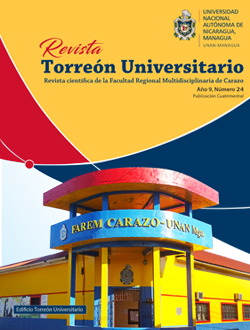Biocidal activity of soursop extracts (Annona muricata L.) in larval stage III of the Aedes aegypti L. mosquito
DOI:
https://doi.org/10.5377/torreon.v9i24.9721Keywords:
soursop, Annona muricata L., Aedes aegypti L., larvicidal, seedAbstract
Currently, the mosquito (Aedes aegypti) is the main vector for the transmission of infectious disease viruses with high pathogenic reactivity such as dengue, chikungunya, and zika, which combined with high-risk factors or little medical attention, can be lethal. Additionally, health systems are facing a rising problem, the lack of a control method for this mosquito that is easily proliferated and exhibit increased resistance to traditionally insecticides, reducing the available options for its eradication. This research evaluated the larvae activity of soursop leaf and seed extracts (Annona muricata L.) obtained by two extraction methods (Soxhlet and idle) as an alternative to larval stage III of A. aegypti control. Also, we evaluated the effect of the solvent and the environmental conditions on larvae mortality. The results have shown that the differences in the proximal composition of the samples are dependent not only on the matrix (leaf or seed) used but also on their origin. Likewise, the larvicidal effect of seed and leaf extracts of soursop on larval stage III of A. aegypti is confirmed; however, the effectiveness of the extract is dependent on the extraction method. Controls indicated that the environment and the solvent did not influence when assessing lethality.
Downloads
997
PDF 222
HTML (Español (España)) 308
HTML 151
References
Alfaro, J. (2017). Caracterización epidemiológica de la epidemia de dengue en el distrito seis de Managua Nicaragua 2015, Monografía Universidad Nacional Autónoma de Nicaragua. P. 86.
Castillo, J y Ramos J. (2016). Evaluación de la eficacia temefos (Abate®) en condiciones de laboratorio y su utilidad en el control de larvas de Aedes aegypti, vector del dengue y Chikungunya en el barrio Bóer. Monografía Universidad Nacional Autónoma de Nicaragua.
Cuello M, Jaramillo G, Canchingre E, Pérez J, Castro C, Cabrera O. (2017). Determinación de componentes nutricionales presentes en las hojas secas de Annona muricata L. (guanábana). Revista Cumbres. 2017; 3(1): 09-28.
Eiman M., Introini M., Ripoll C. (2016). “Directrices para la prevención y control de Aedes aegypti”. Ministerio de Salud de la Nación Av. 9 de Julio 1925 (C1073ABA), Cdad. Autónoma de Bs. As., República Argentina.
Fasakin A., Fehintola E., Obijole O., Oseni O. (2007). Compositional analyses of the seed of sour sop, Annona muricata L., as a potential animal feed supplement. Scientific research and essays 3(10):521-523.
Francia, A. y Maciá, A. (2011). Efectos de la competencia larval en los mosquitos de contenedores artificiales, Aedes aegypti y Culex pipiens (Diptera: Culicidae) en condiciones semi-controladas. Revista de la Sociedad Entomológica Argentina, 70 (3-4), 305-315.
Quispe E., et al. (2014). Ciclo biológico y Tabla de Vida de Aedes aegypti, en laboratorio: Trujillo (Perú), 2014. Revista Científica de Estudiantes. REBIOLEST 2015; 1(3): e47.
R Core Team. (2019). R: A language and environment for statistical computing. R Foundation for Statistical Computing, Vienna, Austria. URL https://www.R-project.org/.
Vit P., Santiago B. y Pérez Pérez E. M. (2014). Composición química y actividad antioxidante de pulpa, hoja y semilla de guanábana (Annona muricata L.). Interciencia, 39(5), 350-353.
Downloads
Published
How to Cite
Issue
Section
License
Los autores que publican en esta revista están de acuerdo con los siguientes términos.
- El autor o los autores de los artículos, ensayos o investigaciones conceden a la Universidad Nacional Autónoma de Nicaragua, Managua (UNAN-Managua) los derechos de edición (copyright) del trabajo enviado, por consiguiente la Universidad cuenta con el derecho exclusivo para publicar el artículo durante el periodo completo de los derechos de autor.
- Estos derechos de autor/ autores autorizan a la Revista Torreón Universitario y a la Universidad editar y divulgar/publicar el artículo en dicha Revista, incluyendo reproducción impresa y electrónica, el almacenamiento, recuperación y cualquier otro tipo de publicación, y fuentes de información secundaria como servicios de resúmenes y bases de datos, así mismo la facultan a proteger el artículo contra el uso no autorizado para su difusión por medios impresos o electrónicos (PDF, HTML, EPUB, XML u otros).
Licencia para el uso del contenido
La revista hace uso de la Licencia Creative Commons Atribución-NoComercial-SinDerivar 4.0 Internacional.
Bajo esta declaración:

Este revista está sujeta a una licencia de Creative Commons Reconocimiento-NoComercial-SinObraDerivada 4.0 Internacional. Puede ser copiada, distribuida y transmitida públicamente siempre y cuando se cite al autor y la fuente (Revista Torreón Universitario), no debe modificarse ni utilizarse con ningún fin comercial. La licencia completa se puede consultar en http://creativecommons.org/licenses/by-nc-nd/4.0/.



